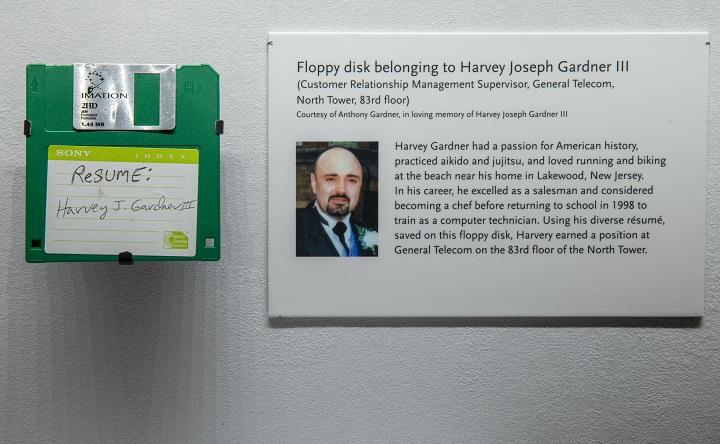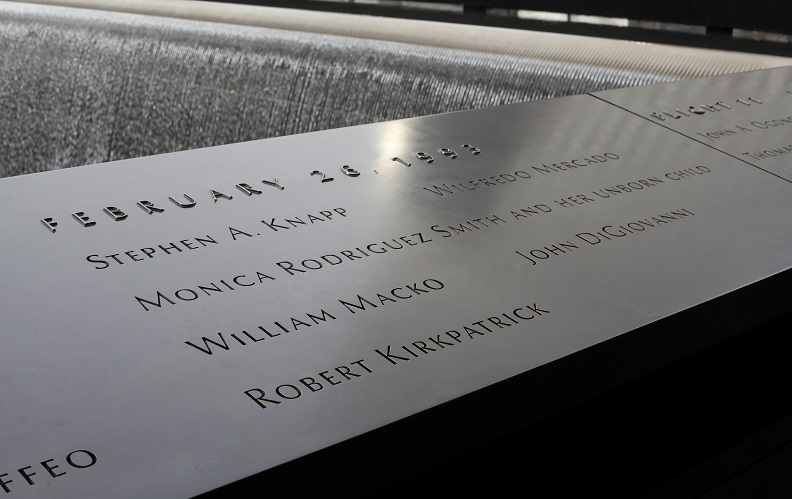Make a donation to the museum
On View: Harvey Joseph Gardner III’s Floppy Disk
On View: Harvey Joseph Gardner III’s Floppy Disk

On September 11, 2001, my brother Harvey Joseph Gardner III left his house before dawn for the long commute from the Jersey Shore to his office on the 83rd floor of the North Tower. Just before 9 a.m., my brother Mark reached him by phone, and despite the chaos unfolding in his office, Harvey could be heard comforting and directing his colleagues. Harvey was calm, brave, reassuring, and thoughtful of others in his final hours despite the horror that he faced. On his last day, he was all the things we knew him to be in life and so much more.
Harvey was only 35 years old when he was killed that September morning. Nearly two decades have passed since that day that changed our family, our country, and the world forever, but his memory and his example remain a potent source of inspiration for my family and others who learn his story.
In life, Harvey was wise and confident, yet humble enough to see himself as a work in progress, always striving to be the best version of himself. Throughout his short life, he always found the time to pursue his life goals while engaging in an ever-expanding list of hobbies and interests—whether it was practicing martial arts, biking at the Jersey Shore, or learning about American history.
So my family wasn’t surprised in the late 1990s when Harvey announced that he was leaving a successful sales career to enroll in an IT training school. He briefly debated between enrolling in culinary school, but then ultimately decided that his interest in computers and technology edged out his passion for cooking. True to form, he thrived in the program, built computers from scratch, and learned all he could to gain the skills needed to break into the IT field.
A bright green floppy disk that belonged to Harvey is now among a selection of artifacts currently on view in the 9/11 Memorial Museum’s In Memoriam exhibition. It’s a particularly meaningful artifact for our family because it bears his handwritten note, “RESUME: Harvey J. Gardner III.” All these years later, it’s still comforting to see his handwriting—it brings him closer to us in a sense. The diverse and accomplished resume he used to earn his position at General Telecom is saved on that floppy disk, now a relic of our collective technological past (so an artifact in its own right). The disk also conveys the painful irony that it was Harvey’s career choice that led to the job that brought him to the North Tower that fateful day.
The floppy disk and other artifacts on display speak to victims’ hobbies, writings, or drawings, providing an intimate glimpse into the lives of the people we honor every day at the 9/11 Memorial & Museum. Visitors to In Memoriam can learn more about each of the 2,983 people killed on 9/11 and in the 1993 bombing of the World Trade Center by exploring the interactive tables in the gallery.
My family is so grateful that the 9/11 Memorial Museum now serves as the repository for these precious memories and is sharing Harvey’s story with the world. I would encourage anyone interested in donating materials in memory of a loved one—objects, photographs, or audio remembrances—to contact collections@911memorial.org.
I have seen firsthand how these seemingly ordinary objects, like a floppy disk, provide a tangible connection to our collective past and to the everyday heroes like Harvey whose stories have the power to inspire us to be the best versions of ourselves.
By Anthony Gardner, Brother of Harvey Joseph Gardner III
Previous Post
Q&A with Mary McCord: What Everyone Needs to Know About Prosecuting Domestic Terrorism

On Thursday, February 20, Mary McCord of the Institute for Constitutional Advocacy and Protection and Seamus Hughes of George Washington University’s Program on Extremism will discuss what constitutes “domestic terrorism” and the challenges in prosecuting it during a public program at the 9/11 Memorial Museum.
Next Post
Remembering the Victims of the 1993 Bombing of the World Trade Center

Today we honor the six victims of the first attack on the World Trade Center on February 26, 1993.